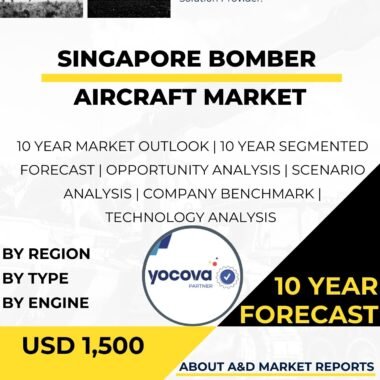Description
The bomber aircraft market in Japan has been a significant area of focus and strategic importance in recent years, driven by the nation’s commitment to enhancing its defense capabilities and addressing security challenges in the Indo-Pacific region. Bomber aircraft play a crucial role in modern military operations, providing long-range strike capabilities and deterrence against potential adversaries.
Japan’s security concerns are influenced by various factors, including the changing dynamics in the Indo-Pacific region, territorial disputes, and the development of advanced military technologies by neighboring countries. As a result, Japan has been proactive in modernizing its defense forces and investing in advanced bomber aircraft to bolster its aerial strike capabilities and deter potential threats.
One of the primary applications of bomber aircraft in Japan is in the defense sector. The Japan Air Self-Defense Force (JASDF) operates bomber aircraft that provide a strategic deterrence capability. While Japan maintains a self-defense-oriented military posture, its bomber fleet is a critical component of its overall defense strategy, allowing the JASDF to project power and respond to potential security threats.
The JASDF currently operates the Mitsubishi F-15J and the Kawasaki T-4 aircraft, which are not traditional bomber aircraft but have the capability to carry and deliver precision-guided munitions. The F-15J is a multirole fighter aircraft that has been modified to carry air-to-ground munitions, while the T-4 is a training aircraft equipped for light attack roles. These aircraft provide the JASDF with the ability to conduct limited ground attack missions, enhancing Japan’s deterrence posture and capability to respond to emerging security challenges.
Moreover, Japan’s commitment to indigenous defense capabilities has driven the development of domestically produced bomber aircraft. The Mitsubishi Heavy Industries is a prominent Japanese defense contractor involved in research, development, and production of advanced aircraft for the JASDF. Collaboration between the government and the domestic defense industry fosters innovation and contributes to the growth of the domestic bomber aircraft market.
Japan’s bomber aircraft market is also influenced by its alliance with the United States. As part of its defense cooperation with the U.S., Japan has access to advanced military technologies and platforms. The U.S. has been a key supplier of military aircraft, including bomber aircraft, to Japan. This alliance strengthens Japan’s defense capabilities and contributes to regional security and stability.
Challenges in the bomber aircraft market in Japan include addressing potential threats from emerging military technologies and the need to adapt to evolving security challenges. As adversaries develop more sophisticated air defense systems and anti-access/area-denial (A2/AD) capabilities, Japan must continuously upgrade its bomber aircraft and tactics to stay ahead of potential threats. This necessitates ongoing research and development efforts to enhance the survivability and effectiveness of bomber aircraft in contested environments.
Moreover, ensuring interoperability and compatibility of bomber aircraft with other elements of the JASDF’s force structure is crucial for efficient and effective military operations. Standardizing equipment, communication systems, and tactics across different units requires careful planning and coordination.
Cost considerations also influence Japan’s bomber aircraft procurement decisions. Developing and acquiring advanced bomber aircraft can be expensive, requiring prudent budget allocation and prioritization. Japan must balance investing in cutting-edge technologies with maintaining other critical aspects of its defense capability.
In conclusion, the bomber aircraft market in Japan has been a significant area of focus and strategic importance, driven by the nation’s commitment to enhancing its defense capabilities and addressing security challenges in the Indo-Pacific region. Bomber aircraft play a critical role in modern military operations, providing long-range strike capabilities and deterrence against potential adversaries. The collaboration between the government and the domestic defense industry, as well as international partnerships with allied nations, fosters innovation and contributes to the growth of the domestic bomber aircraft market. Challenges related to emerging threats, compatibility, cost considerations, and technology development must be addressed to further enhance Japan’s bomber aircraft capabilities and ensure its ability to project power and respond to evolving security challenges in the dynamic and evolving Indo-Pacific region. With its strategic focus on modernizing its defense forces, Japan remains committed to leveraging advanced bomber aircraft to enhance its aerial strike capabilities and contribute to regional and global security.




